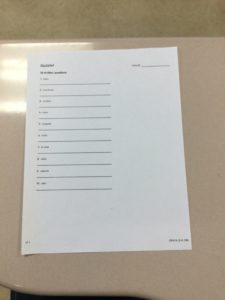Teachers need to take advantage of all the tools available to us which can give students a variety of exposure to language, and which can help us to be more efficient in the creation and use of materials. Although it is perhaps more commonly associated with traditional teaching (flashcards, isolated vocabulary, drills, etc), I have found Quizlet to be a useful and time-saving addition to my CI-based class. Here is how I use it, and which features I particularly like.
1. target word list. Many students enjoy playing vocab games, and for some it does help their retention, or at very least, gives them the impression that they are learning, and confidence. If you prefer to work with structures that contain multiple words, or words as they appear in context, rather than isolated forms, you have the flexibility to include as many or few words in your single entries. for example, I like to encourage students to think about word endings by including different forms of a word as different entries, e.g. amare = to love; amant = they love. Doing this is a way to “teach grammar” while still observing the CI principle that syntactical variations should be taught lexically (i.e. as discrete vocabulary items, and in context)
2. quiz generator. Once you have entered your target vocab, you can generate a variety of assessments (multiple choice, write-in, true/false, any number of questions,) In addition, Quizlet will generate different variations of the same quiz, in case you have students who miss a day, or who are present for a quiz and/or class correction, but who are not taking the quiz.

3. cards for activities. When you choose “print” you have the option to print out a traditional vocab list, or print the words as cards which you (or students) can cut out for matching activities, etc.
4. Large network of teachers. Chances are, another teacher has created study sets related to your language, unit, textbook, target vocab, activity, etc. If you teach a commonly-used curriculum or textbook, there may be tens, or hundreds of study sets already out there. Then you can either use those as-is, or modify and save them for your own class. Again, no need to spend time reinventing the wheel.
5. Students know Quizlet and can easily use it on a variety of platforms. Most of my students have used Quizlet before in other classes, and they enjoy the interface (especially the competitive games, with high-score honors). Also, the app works with most smartphones. In the interest of equity, having a few computers/tablets in the room, and making paper printouts available, can ensure that all students are able to benefit from this resource.
6. It’s free. All the options I mentioned come with the free account. Later I may want to explore the addition options, but I’m very happy with the basic service.
I have not yet explored the new live options, or much beyond what I have listed above. But even in this rudimentary way, I have found Quizlet to save me time, and give me and my students a variety of ways to interact with the language, which supports the comprehension-based work I do in my classroom. If you want to visit my Quizlet pages, my username is “magisterpiaz.”
